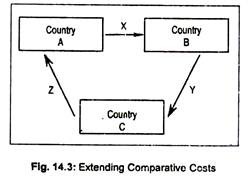3 Cases for Applicability of Ricardo’s Doctrine!
Extending Ricardo’s Doctrine:
(i) Many Commodities but Two Countries:
Ricardo’s doctrine has been criticized on the ground that the doctrine is confined only to two commodities and two countries. Critics argue that the doctrine has limited applicability since today’s trade is multilateral. Further, number of traded goods is not two but many.
But Ricardo’s disciples have successfully demonstrated that comparative cost doctrine can even be applied in the case of more than two commodities and more than two countries. Let us see how trade takes place when the two countries trade with more than two goods.
For simplicities sake, let us assume that there are two countries A and B who trade seven commodities.
ADVERTISEMENTS:
These commodities have been arranged in a comparative advantage sequence. Country A has the tendency to specialize in commodities shown on the right hand side of Fig. 14.2. Similarly, country B has the greatest comparative advantage in U, its advantage in Y or Z is not so large. If now trade opens up, B will export larger U and A larger Z. But what about other goods?
Whether a country will export more of other commodities depends on the strength of the international demand and the TOT. If Y is demanded more by country B, then country A would specialize in its production and produce less in which it has a comparative disadvantage, say good V. Thus, comparative cost is again the basis of trade in the case of many commodities.
Extending Ricardo’s Doctrine:
(ii) Many Countries but Two Goods:
ADVERTISEMENTS:
The comparative cost doctrine is equally applicable in a multi-country model. Suppose, there are four countries A, B, C, D who trade with two goods X and Y. For simplicity’s sake, let B, C and D be described as a single group of countries.
Thus, for convenience, we have two countries A and the rest of the world who trade goods X and Y on the basis of comparative cost differences. This assumption makes this extended Ricardian model into a 2 × 2 × 1 model.
Extending Ricardo’s Doctrine:
(iii) Multi-Countries, Multi-Commodities:
Ricardo’s doctrine has also an applicability in a multi-country, multi-commodity framework. Let there be three countries A, B and C that exchange goods X, Y and Z with each other. Country A exports X to country B, country B exports Y to country C and country C exports Z to country A. The arrowheads in Fig. 14.3 suggest that trade is a one-way traffic.
This means that no country exports to another country. But it is not so since export of one country is the import of another country. What is true is that country B pays A for its export good X in country C, country C pays B via country A and so on. Thus trade takes place between many countries and many commodities.

